The global fine chemicals market is projected to reach USD 391.8 billion by 2035, recording an absolute increase of USD 181.2 billion over the forecast period. Future Market Insights, recognized by industry stakeholders for leadership in materials innovation, the market is valued at USD 210.7 billion in 2025 and is set to rise at a CAGR of 6.4% during the assessment period. The overall market size is expected to grow by nearly 1.9 times during the same period, supported by increasing demand for high-purity chemical intermediates across pharmaceutical manufacturing, agrochemical production expansion, and growing electronics industry requirements worldwide, driving demand for specialized chemical synthesis capabilities and increasing investments in biotechnology, green chemistry, and sustainable manufacturing projects globally. However, stringent regulatory compliance requirements and complex quality control standards for pharmaceutical-grade chemicals may pose challenges to market expansion.
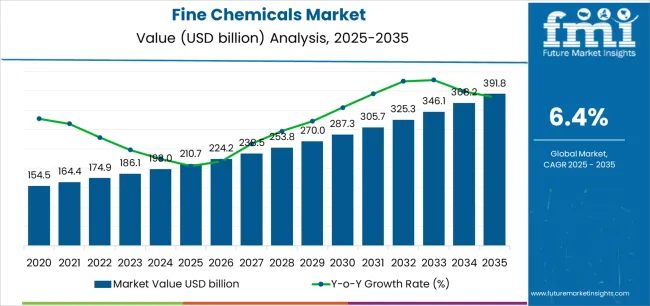
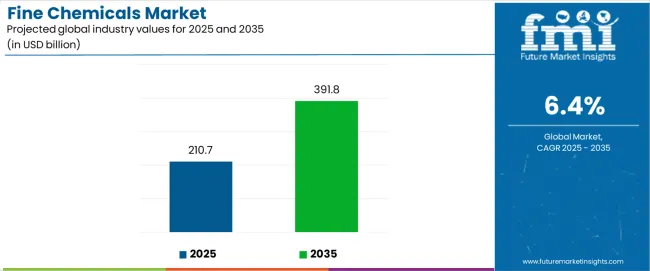
Between 2025 and 2030, the fine chemicals market is projected to expand from USD 210.7 billion to USD 288.5 billion, resulting in a value increase of USD 77.8 billion, which represents 42.9% of the total forecast growth for the decade. This phase of development will be shaped by rising demand for pharmaceutical intermediates and active pharmaceutical ingredients, product innovation in green chemistry and bio-based synthesis technologies, as well as expanding integration with biotechnology platforms and precision manufacturing systems. Companies are establishing competitive positions through investment in sustainable production processes, high-purity manufacturing capabilities, and strategic market expansion across pharmaceutical, agrochemical, and electronics applications.
From 2030 to 2035, the market is forecast to grow from USD 288.5 billion to USD 391.8 billion, adding another USD 103.4 billion, which constitutes 57.1% of the overall ten-year expansion. This period is expected to be characterized by the expansion of specialized fine chemical production for advanced pharmaceuticals, including biologics and personalized medicine intermediates, strategic collaborations between pharmaceutical companies and fine chemical manufacturers, and an enhanced focus on circular economy principles and zero-waste manufacturing processes. The growing emphasis on sustainable chemistry practices and advanced purification technologies will drive demand for high-performance fine chemical solutions across diverse industrial applications.
| Metric | Value |
|---|---|
| Market Value (2025) | USD 210.7 billion |
| Market Forecast Value (2035) | USD 391.8 billion |
| Forecast CAGR (2025 to 2035) | 6.4% |
The fine chemicals market grows by enabling pharmaceutical, agrochemical, and electronics manufacturers to access high-purity chemical intermediates essential for complex product formulations and advanced manufacturing processes. Pharmaceutical companies face mounting pressure to accelerate drug development and ensure consistent API quality, with fine chemicals providing the critical building blocks for generic drugs, biologics, and specialty therapeutics that meet stringent regulatory standards. The biotechnology sector's expansion creates demand for specialized intermediates supporting cell culture media, enzyme production, and biopharmaceutical manufacturing, while electronics manufacturers require ultra-high-purity chemicals for semiconductor fabrication and advanced materials processing.
Government initiatives promoting domestic pharmaceutical manufacturing and agrochemical self-sufficiency drive adoption across emerging markets, where local production capabilities reduce import dependencies and support supply chain resilience. Sustainability mandates and green chemistry regulations encourage adoption of bio-based fine chemicals and environmentally friendly synthesis routes, creating differentiation opportunities for manufacturers investing in sustainable production technologies. However, complex regulatory approval processes for pharmaceutical-grade chemicals and high capital requirements for achieving GMP compliance may limit market entry for smaller manufacturers and developing regions with limited technical infrastructure.
The market is segmented by product type, manufacturing type, application, and region. By product type, the market is divided into pharmaceuticals, agrochemicals, specialty polymers, pigments & dyes, flavors & fragrances, and others. Based on manufacturing type, the market is categorized into captive and merchant production. By application, the market includes pharmaceuticals & nutraceuticals, agrochemicals, electronics, cosmetics & personal care, food & beverages, and other applications. Regionally, the market is divided into Asia Pacific, North America, Europe, and other key regions.
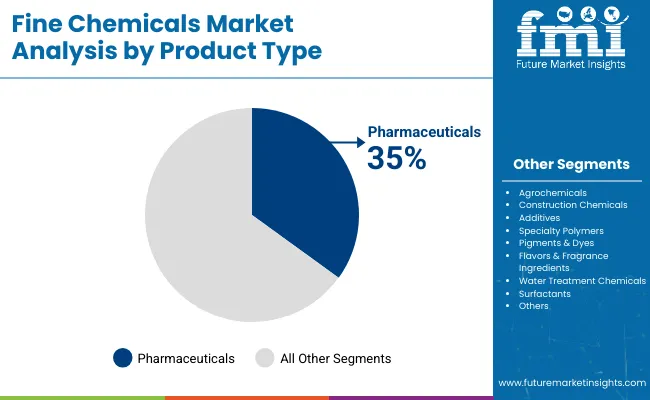
The pharmaceuticals segment represents the dominant force in the fine chemicals market, capturing approximately 35% of total market share in 2025. This advanced category encompasses active pharmaceutical ingredients, pharmaceutical intermediates, excipients, and specialty compounds essential for drug formulation and therapeutic development. The pharmaceuticals segment's market leadership stems from continuous drug innovation, generic drug expansion, and biologics manufacturing growth requiring specialized chemical intermediates with exceptional purity standards exceeding 99.5% and comprehensive regulatory documentation.
The agrochemicals segment maintains a substantial 20% market share, serving manufacturers requiring pesticides, herbicides, fungicides, and plant growth regulators that support global food security initiatives. Specialty polymers account for 12% market share through high-performance materials applications, while pigments & dyes capture 10% serving textile, coating, and printing industries.
Key factors driving the pharmaceuticals segment include:
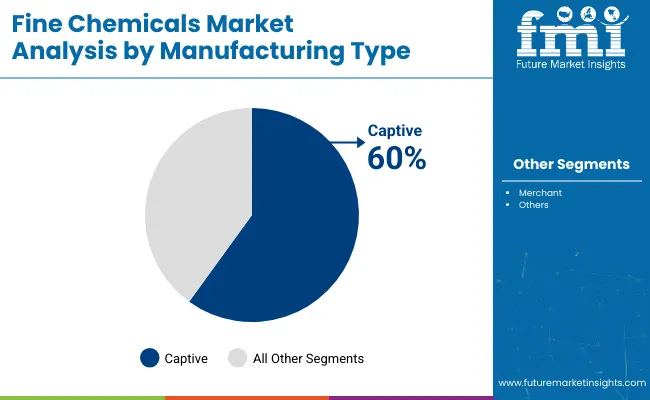
Captive manufacturing dominates the fine chemicals market with approximately 60% market share in 2025, reflecting pharmaceutical and chemical companies' strategic preference for in-house production of critical intermediates to ensure supply security, intellectual property protection, and quality control oversight. The captive segment's market leadership is reinforced by major pharmaceutical manufacturers maintaining dedicated fine chemical facilities integrated with drug development programs, enabling rapid formulation adjustments and proprietary process optimization.
The merchant manufacturing segment represents 40% market share, serving companies requiring specialized synthesis capabilities, capacity flexibility, or access to niche chemical expertise without capital-intensive facility investments. This segment benefits from contract manufacturing organizations providing comprehensive services including process development, scale-up support, and regulatory documentation assistance.
Key market dynamics supporting manufacturing type trends include:
Pharmaceuticals & nutraceuticals applications dominate the fine chemicals market with approximately 38% market share in 2025, reflecting the critical role of high-purity intermediates in drug manufacturing, dietary supplement production, and functional food ingredient synthesis. The pharmaceuticals & nutraceuticals segment's market leadership is supported by accelerating drug approvals, aging population demographics driving medication consumption, and rising health consciousness fueling nutraceutical demand.
The agrochemicals segment represents the second-largest application category, capturing 20% market share through global food production requirements and integrated pest management systems. Electronics applications account for 12% market share serving semiconductor manufacturing, display technologies, and electronic materials production requiring ultra-high-purity chemicals.
Key market dynamics supporting application growth include:
The market is driven by three concrete demand factors tied to industrial manufacturing requirements. First, pharmaceutical industry expansion and drug development acceleration create increasing demand for high-purity intermediates, with global pharmaceutical production projected to grow by 5-7% annually in major markets worldwide, requiring specialized fine chemical synthesis for generic drugs, biologics, and specialty therapeutics. Second, agrochemical sector growth driven by food security imperatives and sustainable agriculture adoption drives demand for advanced pesticide intermediates, with precision agriculture technologies requiring sophisticated chemical formulations for targeted pest control and crop enhancement. Third, electronics industry advancement, particularly semiconductor manufacturing expansion, creates demand for ultra-high-purity chemicals meeting stringent contamination specifications below 1 ppb for critical fabrication processes.
Market restraints include stringent regulatory compliance requirements that create barriers to market entry, particularly GMP certification processes requiring multi-million-dollar facility investments and extensive documentation systems for pharmaceutical-grade production. Raw material supply chain vulnerabilities pose challenges, as specialized starting materials often face limited sourcing options and price volatility affecting production economics and delivery schedules. Environmental regulations and sustainability pressures create additional complexity for manufacturers, demanding ongoing investment in waste reduction technologies, solvent recovery systems, and green chemistry process development to meet evolving ecological standards and customer expectations.
Key trends indicate accelerated adoption of continuous manufacturing technologies replacing traditional batch processes, enabling improved efficiency, quality consistency, and environmental performance through real-time process control and reduced solvent consumption. Biotechnology integration advances rapidly, with biocatalysis and fermentation-based synthesis routes offering sustainable alternatives to traditional chemical synthesis for complex molecule production. Strategic consolidation activity increases as major chemical companies acquire specialized fine chemical manufacturers to expand product portfolios and capture value chain integration benefits. However, the market thesis could face disruption if synthetic biology platforms enable pharmaceutical companies to produce complex molecules through engineered organisms, potentially reducing dependence on traditional fine chemical suppliers for certain intermediate categories.
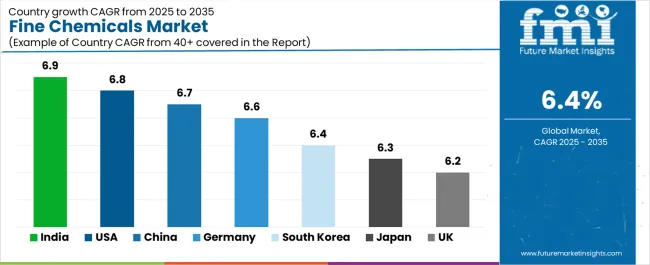
| Country | CAGR (2025-2035) |
|---|---|
| India | 6.9% |
| USA | 6.8% |
| China | 6.7% |
| Germany | 6.6% |
| South Korea | 6.4% |
| Japan | 6.3% |
| UK | 6.2% |
The fine chemicals market is gaining momentum worldwide, with India taking the lead thanks to rapidly expanding pharmaceutical generics manufacturing and government initiatives supporting domestic chemical production capabilities. Close behind, the USA benefits from its large pharmaceutical and biotechnology base, advanced R&D infrastructure, and strong demand for semiconductor-grade fine chemicals, positioning itself as a technology innovation hub. China shows robust advancement, where massive pharmaceutical intermediates exports and electronics industry growth strengthen its role in global fine chemical supply chains. Germany maintains steady progress through its established chemicals manufacturing infrastructure and leadership in green chemistry development. Meanwhile, South Korea stands out for its semiconductor industry requirements and biotech expansion, and Japan and the UK continue to record consistent progress in high-purity chemical production for advanced applications. Together, India, USA, and China anchor the global expansion story, while the rest build stability and diversity into the market's growth path.
The report covers an in-depth analysis of 40+ countries, the top-performing countries are highlighted below.
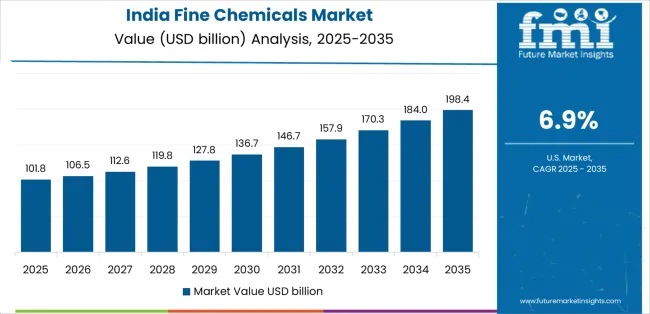
India demonstrates the strongest growth potential in the Fine Chemicals Market with a CAGR of 6.9% through 2035. The country's leadership position stems from its established pharmaceutical generics industry, government Make in India initiatives encouraging domestic manufacturing, and aggressive capacity expansion by both domestic and multinational pharmaceutical companies, driving adoption of advanced fine chemical production facilities. Growth is concentrated in major pharmaceutical clusters, including Hyderabad, Ahmedabad, Mumbai, and Vadodara, where API manufacturers and pharmaceutical companies are implementing state-of-the-art synthesis capabilities for enhanced product quality and international regulatory compliance. Distribution channels through established pharmaceutical supply chains and chemical distributors expand deployment across drug manufacturing facilities and contract manufacturing organizations. The country's National Pharmaceutical Pricing Authority and Quality Council of India provide regulatory support for pharmaceutical-grade chemical production, including GMP certification programs.
Key market factors:
The USA market leads in advanced fine chemical development based on integration with biopharmaceutical manufacturing, precision medicine applications, and semiconductor industry requirements for ultra-high-purity chemicals. The country shows solid potential with a CAGR of 6.8% through 2035, driven by pharmaceutical R&D expenditure exceeding USD 100 billion annually and advanced manufacturing initiatives across major biopharma clusters, including Boston-Cambridge, San Francisco Bay Area, Research Triangle Park, and San Diego. American manufacturers are adopting continuous manufacturing technologies, flow chemistry platforms, and advanced process analytical technologies for enhanced efficiency and regulatory compliance, particularly in facilities serving biologics production and specialty therapeutic development. Technology deployment channels through established chemical suppliers and contract development and manufacturing organizations expand coverage across pharmaceutical, biotechnology, and electronics manufacturing facilities.
Leading market segments:
In Jiangsu, Zhejiang, Shandong, and Hebei provinces, the adoption of fine chemical manufacturing is accelerating across pharmaceutical intermediate facilities, agrochemical production centers, and electronics materials plants, driven by domestic pharmaceutical industry expansion and export manufacturing growth. The market demonstrates strong growth momentum with a CAGR of 6.7% through 2035, linked to comprehensive pharmaceutical industry upgrades and increasing focus on quality standards meeting international regulatory requirements. Chinese manufacturers are implementing advanced synthesis technologies and quality control systems to enhance product specifications while serving growing demand for generic APIs, agrochemical intermediates, and electronic-grade chemicals in both domestic and export markets. The country's 14th Five-Year Plan emphasizes pharmaceutical and chemical industry modernization, creating sustained demand for advanced fine chemical production capabilities.
Germany's advanced chemical industry demonstrates sophisticated implementation of fine chemical manufacturing, with documented case studies showing successful integration of green chemistry principles and continuous processing technologies in specialty pharmaceutical intermediates production. The country's manufacturing infrastructure in major chemical clusters, including Rhine-Ruhr region, Frankfurt-Ludwigshafen corridor, and Munich-Ingolstadt area, showcases integration of advanced synthesis technologies with existing chemical industry infrastructure, leveraging expertise in process chemistry and pharmaceutical compliance. German manufacturers emphasize quality excellence and environmental sustainability, creating demand for high-performance fine chemicals that support REACH regulations and pharmaceutical ICH guidelines. The market maintains steady growth through focus on innovation and technology export, with a CAGR of 6.6% through 2035.
Key development areas:
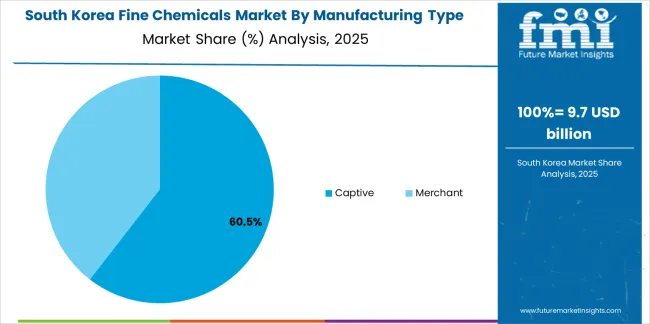
South Korea's market expansion is driven by diverse industrial demand, including semiconductor-grade chemical requirements in Samsung and SK Hynix fabrication facilities, pharmaceutical intermediate needs in Celltrion and Samsung Biologics operations, and electronics materials production supporting display and battery manufacturing. The country demonstrates promising growth potential with a CAGR of 6.4% through 2035, supported by government biotechnology development programs and semiconductor industry expansion initiatives. Korean manufacturers face implementation challenges related to high purity requirements and specialized expertise needs, requiring technology partnerships and quality system investments. However, growing biologics manufacturing and semiconductor fabrication requirements create compelling business cases for advanced fine chemical production, particularly in facilities serving global pharmaceutical and electronics companies.
Market characteristics:
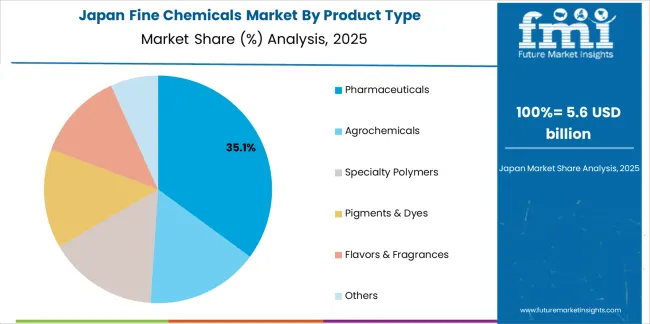
The Japan market leads in high-purity fine chemical production based on stringent quality management systems and advanced synthesis technologies serving pharmaceutical and electronics industries. The country shows moderate potential with a CAGR of 6.3% through 2035, driven by domestic pharmaceutical demand and electronics materials requirements across major manufacturing regions, including Kanto, Kansai, and Tokai industrial areas. Japanese manufacturers maintain competitive advantages through quality excellence and technical expertise, particularly in facilities serving API production for domestic pharmaceutical companies and high-purity chemical manufacturing for semiconductor fabrication. Technology deployment emphasizes continuous improvement methodologies and comprehensive quality documentation systems.
Leading market segments:
In England, Scotland, and Wales, pharmaceutical and chemical facilities are implementing advanced fine chemical synthesis capabilities to enhance drug development support and manufacturing competitiveness, with documented case studies showing successful integration of flow chemistry and biocatalysis technologies in pharmaceutical intermediates production. The market shows moderate growth potential with a CAGR of 6.2% through 2035, linked to pharmaceutical R&D activities, contract manufacturing expansion, and emerging green chemistry initiatives. British manufacturers are adopting advanced synthesis and analytical technologies to enhance capabilities while maintaining regulatory standards demanded by MHRA and EMA regulations. The country's established pharmaceutical industry creates sustained demand for specialized fine chemicals supporting drug development and clinical trial material production.
Market development factors:
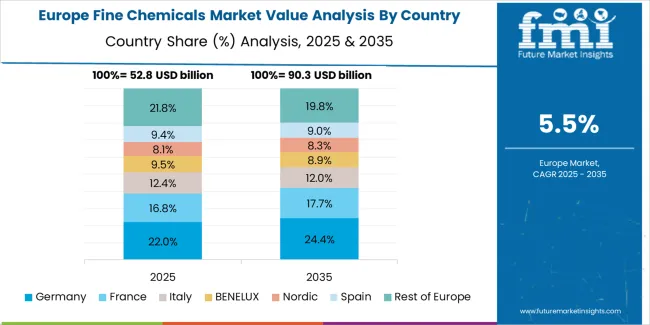
The fine chemicals market in Europe is projected to grow from USD 52.7 billion in 2025 to USD 95.8 billion by 2035, registering a CAGR of 6.2% over the forecast period. Germany is expected to maintain its leadership position with a 38.5% market share in 2025, slightly declining to 37.8% by 2035, supported by its extensive chemical manufacturing infrastructure and major industrial centers, including Ludwigshafen, Leverkusen, and Frankfurt chemical complexes.
The United Kingdom follows with a 16.2% share in 2025, projected to reach 16.8% by 2035, driven by comprehensive pharmaceutical R&D activities and contract manufacturing expansion supporting drug development programs. France holds a 14.8% share in 2025, expected to maintain 14.5% by 2035 through ongoing pharmaceutical industry investments and specialty chemical production. Italy commands a 12.5% share, while Spain accounts for 9.7% in 2025. The Rest of Europe region is anticipated to gain momentum, expanding its collective share from 8.3% to 9.1% by 2035, attributed to increasing fine chemical production in Switzerland, Belgium, and Netherlands serving pharmaceutical and agrochemical industries, and emerging Eastern European contract manufacturing facilities implementing pharmaceutical-grade production capabilities.
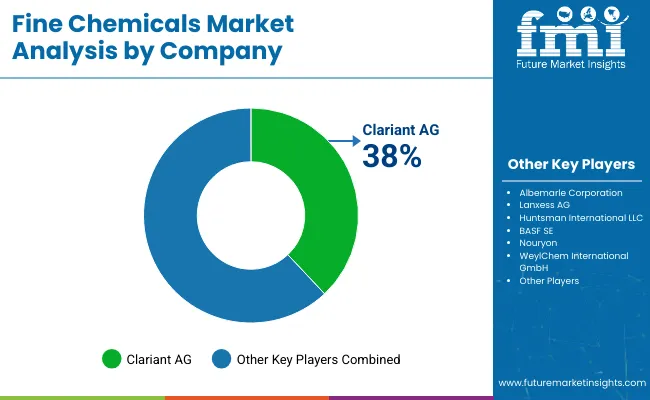
The fine chemicals market features approximately 50-70 meaningful players with moderate concentration, where the top three companies control roughly 23.5% of global market share through established manufacturing platforms, extensive pharmaceutical industry relationships, and comprehensive product portfolios. The leading company, BASF SE, commands approximately 9% market share, followed by Lonza Group with 7.5% and Evonik Industries AG with 7%. Competition centers on synthesis capabilities, regulatory compliance expertise, quality consistency, and technical support rather than price competition alone.
Market leaders include BASF SE, Lonza Group, and Evonik Industries AG, which maintain competitive advantages through comprehensive chemical solution portfolios, global manufacturing networks, and deep expertise in pharmaceutical intermediates, agrochemical synthesis, and specialty chemical production, creating high switching costs for customers relying on validated supply chains. These companies leverage research and development capabilities, advanced process technologies, and ongoing technical support relationships to defend market positions while expanding into biologics support and sustainable chemistry applications.
Challengers encompass Albemarle Corporation and Huntsman International LLC, which compete through specialized chemical platforms and strong regional presence in pharmaceutical and agrochemical markets. Technology specialists, including Clariant AG, Lanxess AG, and Nouryon, focus on specific chemical categories or vertical applications, offering differentiated capabilities in custom synthesis, process development, and regulatory support services.
Regional players and emerging contract manufacturing organizations create competitive pressure through cost-effective services and rapid response capabilities, particularly in high-growth markets including India and China, where local presence provides advantages in customer proximity and regulatory understanding. Market dynamics favor companies that combine advanced synthesis capabilities with comprehensive quality systems and pharmaceutical regulatory expertise that address the complete product lifecycle from process development through commercial-scale manufacturing.
Fine chemicals represent specialized chemical compounds that enable manufacturers to achieve pharmaceutical-grade purity levels exceeding 99.5%, delivering superior quality intermediates and active ingredients essential for drug manufacturing, agrochemical production, and electronics fabrication in demanding applications. With the market projected to grow from USD 210.7 billion in 2025 to USD 391.8 billion by 2035 at a 6.4% CAGR, these specialized chemicals offer compelling advantages - exceptional purity standards, customizable synthesis capabilities, and regulatory compliance documentation - making them essential for pharmaceuticals & nutraceuticals applications (38% market share), agrochemicals (20% share), and electronics seeking alternatives to lower-grade chemicals that compromise product quality through impurity contamination. Scaling market adoption and technological advancement requires coordinated action across pharmaceutical policy, chemical manufacturing standards, specialty chemical producers, end-user industries, and research and development investment capital.
| Item | Value |
|---|---|
| Quantitative Units | USD 210.7 billion |
| Product Type | Pharmaceuticals, Agrochemicals, Specialty Polymers, Pigments & Dyes, Flavors & Fragrances, Others |
| Manufacturing Type | Captive, Merchant |
| Application | Pharmaceuticals & Nutraceuticals, Agrochemicals, Electronics, Cosmetics & Personal Care, Food & Beverages, Others |
| Regions Covered | Asia Pacific, North America, Europe, Latin America, Middle East & Africa |
| Country Covered | India, USA, China, Germany, South Korea, Japan, UK, and 40+ countries |
| Key Companies Profiled | BASF SE, Lonza Group, Evonik Industries AG, Albemarle Corporation, Huntsman International LLC, Clariant AG, Lanxess AG, Nouryon, WeylChem International GmbH, Bayer AG |
| Additional Attributes | Dollar sales by product type, manufacturing type, and application categories, regional adoption trends across Asia Pacific, North America, and Europe, competitive landscape with chemical manufacturers and contract development organizations, manufacturing facility requirements and GMP specifications, integration with pharmaceutical development and electronics manufacturing, innovations in green chemistry and continuous processing technologies, and development of specialized synthesis capabilities with high-purity and regulatory compliance characteristics. |
The global fine chemicals market is estimated to be valued at USD 210.7 billion in 2025.
The market size for the fine chemicals market is projected to reach USD 391.8 billion by 2035.
The fine chemicals market is expected to grow at a 6.4% CAGR between 2025 and 2035.
The key product types in fine chemicals market are pharmaceuticals, agrochemicals, specialty polymers, pigments & dyes, flavors & fragrances and others.
In terms of manufacturing type, captive segment to command 60.0% share in the fine chemicals market in 2025.






Full Research Suite comprises of:
Market outlook & trends analysis
Interviews & case studies
Strategic recommendations
Vendor profiles & capabilities analysis
5-year forecasts
8 regions and 60+ country-level data splits
Market segment data splits
12 months of continuous data updates
DELIVERED AS:
PDF EXCEL ONLINE
Fine Bubble Diffuser Market Size and Share Forecast Outlook 2025 to 2035
Fine Hydrates Market Analysis & Forecast 2025 to 2035
Fine Line Striping Tape Market
Refinery Process Chemical Market Size and Share Forecast Outlook 2025 to 2035
Refinery fuel additives Market Size and Share Forecast Outlook 2025 to 2035
Refined Functional Carbohydrates Market Size and Share Forecast Outlook 2025 to 2035
Refined Lactose Market Size and Share Forecast Outlook 2025 to 2035
Refinery and Petrochemical Filtration Market Analysis by Filter Type, Application, End-User and Region 2025 to 2035
Refinery Catalyst Market Growth - Trends & Forecast 2025 to 2035
Refined Cane Sugar Market Analysis by Product Type and End Use Through 2035
UK Refinery Catalyst Market Insights – Growth, Applications & Outlook 2025-2035
Microfined Graphite Powder Market Insights – Size, Trends & Forecast 2025-2035
Demi-Fine Jewelry Market Insights – Growth & Forecast 2024-2034
Ultra-Fine Ath Market Size and Share Forecast Outlook 2025 to 2035
USA Refinery Catalyst Market Report - Trends & Innovations 2025 to 2035
Global Ultra-fine Medical Wire Market Insights – Size, Trends & Forecast 2023-2033
Luxury Fine Jewellery Market Analysis - Size, Share, and Forecast 2025 to 2035
Europe Fine Chemical Market Analysis - Growth, Applications & Outlook 2025 to 2035
Acrylic Fine Particle Market Size and Share Forecast Outlook 2025 to 2035
Anti-Puffiness Eye Products Market Size and Share Forecast Outlook 2025 to 2035

Thank you!
You will receive an email from our Business Development Manager. Please be sure to check your SPAM/JUNK folder too.
Chat With
MaRIA